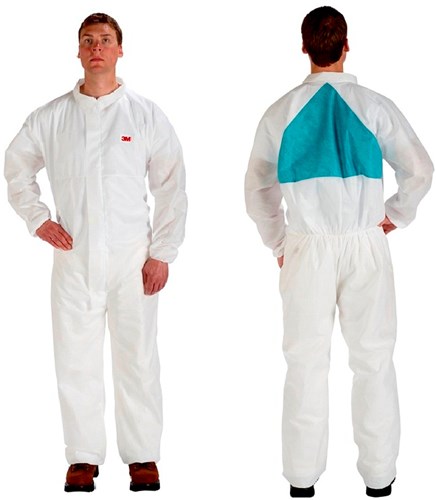3M™ Disposable Protective Coverall 4520CS-BLK-XL, 25 ea per case
-1
3M™ Disposable Protective Coverall 4520CS-BLK-XL, 25 ea per case

Technical Specifications
- Protective coverall helps protect against certain light liquid splashes and hazardous dusts
- Lightweight, breathable material helps keeps workers cool and comfortable
- Extra room in arms and legs allow for free movement on the job
- Seamless shoulders and sleeve tops help provide increased comfort and fewer potential entry points for contaminants
- Meets government standards for Type 6 Splashes, Type 5 Dust, Anti-Static and Nuclear protection
- Does not contain components made from natural rubber latex to help prevent reactions from users with latex sensitivities or restrictions.
3M™ Disposable Protective Coverall Safety Work Wear 4520CS offers high performance protection while delivering worker comfort featuring lightweight, breathable material technologies; extra room in the arms and legs for enhanced mobility; two way zippers for added on off convenience, and storm flaps and seamless shoulders and sleeve tops for extra protection. These coveralls are made from SMMMS material, which helps provide increased breathability and a barrier against hazardous particles and limited liquid splashes. All sizes have anti static treatment on both sizes and knit cuffs and elastic waist and ankles for increased comfort and mobility.
Workplace Protection
3M™ Protective Coveralls are designed for use in industrial workplaces as a physical barrier to help prevent skin contact from liquid splashes and dust in certain work environments. Seamless shoulder and sleeve tops help provide increased comfort and fewer potential entry points for contaminants. In addition, these coveralls meet ANSI 101 1996 size guidelines.
Government Protection Ratings
3M™ Disposable Protective Coverall Safety Work Wear 4520CS meets the following standards: Protective Clothing standard EN 340, Type 6 Splash EN 13034/(EN ISO 17491 4), Type 5 Dust EN ISO 13982 1, Anti Static* EN 11492** and Nuclear EN 1073 2.
* Consult class results in Technical Data Sheet or User Instructions for more information ** All apparel must be grounded for anti static treatment to be effective
Better Comfort Equals Better Compliance
In the "goods producing" sector of industry, which includes manufacturing, construction, and natural resources and mining, skin diseases/disorders rank as the second leading cause of incidence rates and nonfatal occupational illnesses in 2013 according to the Bureau of Labor Statistics.1 Protective apparel is a key factor in improving safety. Yet such garments are only effective if they are worn consistently and matched to the hazards of the job. This protective work wear has been designed to enhance worker comfort and mobility and to potentially boost worker productivity and help improve worker compliance in wearing protective gear. Even in situations where protective work wear is made available to employees, some employers encounter problems with worker compliance in wearing the protective gear, commonly due to complaints about lack of comfort and restricted mobility. To address these issues, 3M built in comfort features such as breathabilty to help keep workers cooler on the job and materials that conform to the natural movement of workers.
When Personal Protective Equipment (PPE) is Necessary
The US Occupational Safety and Health Administration (OSHA) Personal Protective Equipment Standard (29 CFR 1910.132) requires employers to conduct a worksite assessment to determine if hazards are present, or are likely to be present, which necessitate the use of personal protective equipment (PPE). When conducting an assessment to determine whether PPE is needed to help prevent skin contact from liquids, there are many factors to consider. Workers handling, dispensing, using, and transporting liquid materials may need skin coverage. The worksite assessment should evaluate each task taking into account such things as whether skin contact may occur, whether it is continuous or intermittent, the nature of the contact (i.e. immersion, pressurized or non pressurized spray, splash, surface contact, etc), accidental or intentional contact, duration of the exposure and whether the contaminant can be absorbed through the skin.









